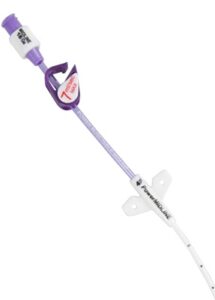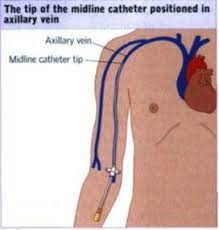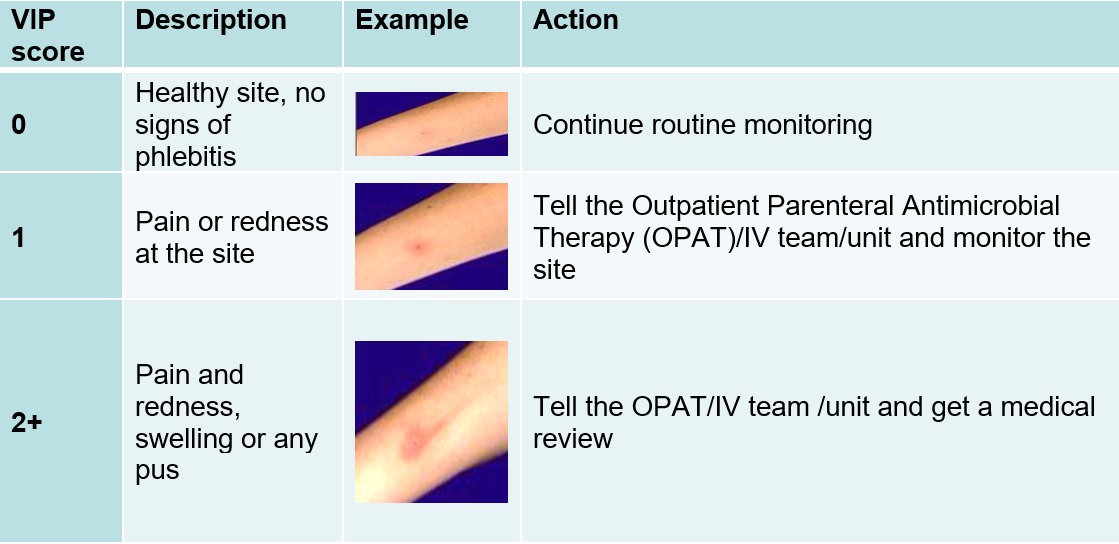Peripheral intravenous (IV) midline catheter (adults only)
You have been advised that the most effective way for you to get your treatment is through a peripheral device called a midline catheter.
What is a midline?
It’s a long, flexible tube that’s sometimes called a line. It’s inserted into a large vein in your upper arm by utilising ultrasound images.
The midline threads up your arm until the tip sits just below your armpit area.
The midline is made of a thin, soft, non-irritant material. It can stay in place for a few weeks, depending on how long you need it. An extension tube and clamp sits at the end of the line outside your body. Your nurse or healthcare professional will use the extension tube to give you your treatment.


How is your midline inserted?
You might be an inpatient on the ward or you’ll come into hospital as an outpatient and a nurse or healthcare professional will insert the midline.
They’ll use a local anaesthetic to stop any discomfort during the procedure.
Your nurse or healthcare professional will insert the midline through the vein until the end sits in the armpit region. Once in place, they’ll fix it on your arm with a product, called a statlock or griplock, and a clear dressing placed over the top. If it has a clamp it should always be closed when not in use. Your clinical team will show you what to look for.
Possible risks and complications
Every procedure has some risks and complications. Your healthcare professional will explain these to you before they insert the midline. They’ll ask you to agree and get your verbal consent to go ahead.
After the procedure, tell your nurse or doctor if you have:
- ongoing bleeding or discharge at the point of entry
- swelling, redness or pain anywhere in your arm, chest or neck.
- a temperature or feel feverish
- increased redness around the area where the midline inserts see the visual infusion phlebitis (VIP) chart below.

Looking after your midline
Once in place, looking after your midline will help ensure it can be kept for a longer period of time.
- Wash your hands
- Anyone who touches your midline must always wash their hands with soap and water and dry their hands thoroughly. Clinical staff must always wear gloves
- Keep the dressing clean and dry
- A nurse or healthcare professional will check and change your dressing 48 hours after they insert your midline.
- Once a week, the outer dressing and statlock device will be changed. The clinician/ healthcare staff will clean the area where the line goes into your skin and then change your dressing and needlefree bung at the end of the extension tubing.
- If at any time your dressing becomes loose or detached from your skin, try to secure the line with tape or a bandage. Contact your unit/nurse to arrange for a new dressing as soon as possible.
- Baths and showers
- You can do both, but do not soak your arm underwater. Always dab the dressing dry if it gets wet.
- You can buy a specialist arm protector to stop your arm getting wet. Talk to the team looking after you for more information.
- You should never swim or use hydrotherapy with a midline in place.
- Exercise
- It is advisable NOT to play sport like golf or lift weights as the midline may move and cause irritation to the vein. You can do normal daily activities as usual.
How is your midline removed? A healthcare professional will do this either at your home or in hospital.
They’ll remove the dressing and gently ease the catheter out. It’s painless and only takes a few minutes. You’ll have a dressing applied to the break in your skin, which you need to leave on for 24 to 48 hours before removing it.
Contact us
Call the healthcare professional or department looking after you if you’re worried about your midline. They’ll check your midline if needed.
IV Therapy/OPAT Team
01296 315485 – Mondays to Sundays, 8.30am to 4.30pm
07810 181584 – Bank Holidays, 9am to 4.30pm (on call basis)
Stoke Mandeville Hospital A&E
01296 315664
